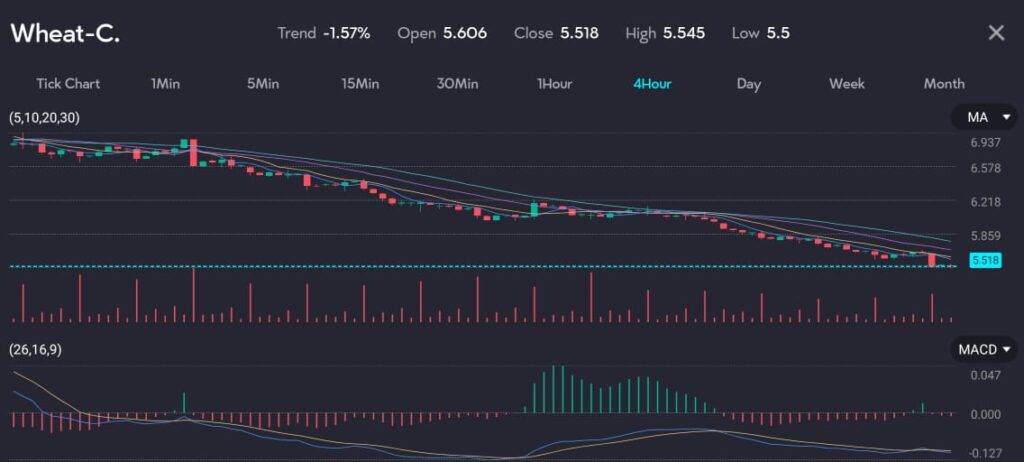Key points:
- Chicago wheat futures fell to $5.73-1/2 a bushel, the lowest since April.
- The U.S. dollar’s strength is impacting wheat, corn, and soybean prices.
Chicago wheat futures experienced a dip to their lowest point since April, driven by a stronger U.S. dollar and an improved supply outlook.
As harvests ramp up across the United States and other key regions, fresh grain supplies are entering the market, contributing to the price decline. Corn futures also fell slightly, while soybeans remained relatively flat.

Picture: Wheat prices drop as seen on the VT Markets app.
Wheat prices drop amid improved harvest outlook
The most-active wheat contract on the Chicago Board of Trade (CBOT), ZW1!, was down 0.4% at $5.73-1/2 a bushel by 0051 GMT after touching $5.73, the lowest since April 22. Meanwhile, CBOT corn, ZC1!, traded 0.3% lower at $4.33-3/4 a bushel, and soybeans, ZS1!, were almost unchanged at $11.20-1/2 a bushel.
Russia’s harvest outlook was previously downgraded, pushing wheat prices to a 10-month high of $7.20 last month. The Russian agriculture minister confirmed that frosts did not significantly impact harvest volumes as most affected farmland was reseeded.
Major producers like Australia and Canada are also experiencing better weather conditions. The U.S. harvest is progressing rapidly, and Ukrainian farmers have begun their crop harvests.
The U.S. dollar index (DXY) has reached its highest level since early May, making U.S. agricultural products more expensive for international buyers. France’s main wheat crop condition remained unchanged for the second consecutive week, although the summer harvest is expected to decline after a damp growing season.
U.S. wheat export sales for the week ending June 13 were higher than trade estimates, while corn sales fell below expectations, as reported by the U.S. Department of Agriculture.
China’s weather threatens corn production
Record high temperatures in northwest and east China are threatening to curb corn production in the world’s second-largest producer and consumer of the grain. Commodity funds were net sellers of CBOT corn and wheat futures on Friday but net buyers of soybeans.
A gauge of global stocks declined for the second straight session on Friday, weighed down by weakness in technology shares.
Meanwhile, the dollar hit its highest level since early May as a gauge of U.S. business activity edged up to a more than two-year high.
Wheat prices fall and supply increases
The falling wheat prices may signal a shift in market dynamics, influenced by an increased supply from key producers and a stronger dollar.
This situation may lead to a temporary easing of global wheat prices, providing some relief to import-dependent countries. However, the ongoing weather challenges in regions like China highlight the potential for supply disruptions in corn, which could create volatility in the market.
You might be interested: Wheat prices retreat with improved global supply
A cautious forecast suggests that while the immediate outlook for wheat appears bearish, any adverse weather events or further currency movements could quickly alter this trajectory.
Soybean prices remaining flat despite other movements suggest underlying stability in that market, possibly due to strong demand offsetting supply concerns.
Start trading now — click here to create your live VT Markets account.









